|
"One of the most
intricately carved and realistically detailed statues (the
Tolu fluorite statue) was discovered
near Tolu, Kentucky, by Willard Johnson, while plowing on the Mildred
Orange farm in may 1954."---2009,
Kevin E. Smith & James V. Miller, "Speaking With The Ancestors, Mississippian Stone
Statuary Of The Tennessee-Cumberland Region," pp. 146.
"As to size, the figure (the
Tolu fluorite statue), perhaps
representing some Indian god, is 10 inches tall and weighs about 18
pounds. To have been done with crude tools, it is a true work of art,
showing great detail."---------1954,
Joe Creason, "Solid Old Citizen," The Sunday Magazine Of
The Courier-Journal, October 3, 1954.
"Back in May, Willard Johnson was cultivating
the corn crop he was raising on Ohio River bottomland near Tolu in
Crittenden County. The cultivator blade bit down through the crusty
soil, lurched to one side and ground against a solid object (the
Tolu fluorite statue) buried in the
earth."--------1954,
Joe Creason, "Solid Old Citizen," The Sunday Magazine Of
The Courier-Journal, October 3, 1954."
"The
statue (the Tolu fluorite statue)
is one of the most detailed of the Tennessee-Cumberland style statuary
and is the only known statue to exhibit a beaded forelock."----2009,
Kevin E. Smith & James V. Miller, "Speaking With The Ancestors, Mississippian Stone
Statuary Of The Tennessee-Cumberland Region," pp. 146.
"Between A.D. 900
and 1600, the native peoples of the Mississippi River Valley and other
areas of the Eastern and Southeastern United States conceived and
executed one of the greatest artistic traditions of pre-Columbian
America."----2007, Kent Reilly III, and James
F. Garber, "Ancient Objects And Sacred Realms," p. 1.

THE TOLU FLUORITE STATUE
A.D. 1150 TO 1200
CRITTENDEN COUNTY, KENTUCKY
A fairly large number
of small fluorite beads, pendants and ear ornaments have been reported
from the area around what is known as the southern Illinois-western
Kentucky fluorspar region. The most spectacular discoveries of
fluorite carvings have been the statues. Only four
complete or almost complete fluorite statues have been illustrated in
archaeological reports beginning in the late 1800's. One of these four,
from Cahokia, disappeared sometime after it was described and
illustrated by Moorhead in 1929. A fifth and sixth example have survived
in the form of the head and shoulders of one from southern Illinois and
another surviving head from what was once reported to have been a
complete statue from western Tennessee. The western Tennessee statue was
discovered in 1845 but was later badly damaged in a fire. The Tolu figure is
the most intricate and realistically carved fluorite statue discovered
to date. |
|

CLICK ON PICTURE FOR LARGER IMAGE
ONLY FOUR COMPLETE OR
NEARLY
COMPLETE DOCUMENTED FLUORITE STATUES
(NOTE: THE STATUE SECOND FROM THE
LEFT HAS A
DIGITALLY RESTORED RIGHT ARM & GOUGE MARK ON THE
UPPER LEFT CHEST)
MIDDLE TO LATE MISSISSIPPIAN
PERIOD
ILLINOIS, INDIANA & KENTUCKY
These four statues are made of
fluorite from the southern Illinois and western Kentucky fluorspar
source area. They are the only complete or nearly complete fluorite
statues that have been illustrated in archaeological reports from
the late 1800's to present day. Only the head of what was once a
complete fifth statue has been reported from western Tennessee and
the head and shoulders of a sixth example from southern Illinois
represent the rest of all the known Mississippian fluorite statues.
The Tolu statue (second from left) stands out in this
picture, from the other three, in several different ways. It's been
described as the most intricate and realistically carved fluorite
statue discovered to date. The free standing arms are immediately
noticeable. It's also seated in the lotus position which also does
not conform to the other statues that are seated with the right
knees up against the chest. The Tolu statue is also the only statue
to have a beaded forelock.
The statue on the left in this picture
was discovered in one of the earth
structures on the Angel site known as mound F. The Angel site is
located just up river from Evansville, Indiana. The second figure
from the left is the Tolu statue. It
was discovered by Willard Johnson in a
cultivated field west of Tolu, Kentucky on a site located near the
south bank of the Ohio River. (Note: The picture of this statue has
a digitally restored right arm & gouge mark on the upper left chest
area.) The third statue is known as the
Anna figure and it was excavated from a mound in Union County,
Illinois by Thomas M.
Perrine in 1873. The image of the statue on the right is taken from
a black and white photograph published in 1929 and described by
Warren K. Moorehead. He simply describes it as "Number 7 is of
fluorspar and about twelve inches high. It was found on the bluffs
directly east of Cahokia." But unfortunately the location of this
fluorite statue has been lost for many years. |
|
|
The first
description of the Tolu statue appears in a Louisville newspaper article
in 1954 called "Solid Old Citizen." The statue was discovered by Willard
Johnson in a cultivated field in May of that same year. The statue had
been struck at the upper left chest area and the left arm was broken
away but later restored. The right arm was never recovered and is still
missing. The Tolu statue has changed hands four times and it's the only
fluorite statue that still resides in a private collection. |
|
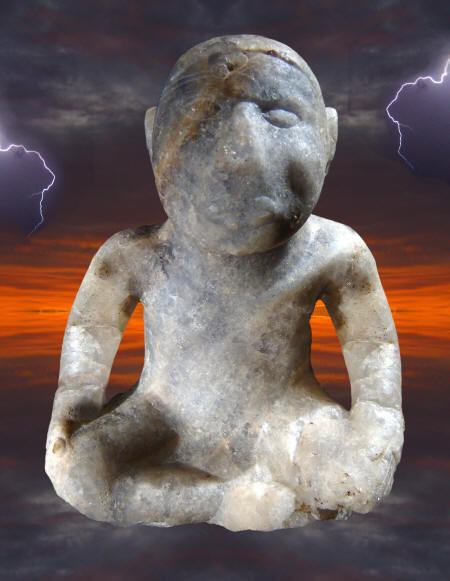
CLICK ON PICTURE FOR LARGER IMAGE OF
UN-RESTORED STATUE
THE TOLU FLUORITE STATUE
(NOTE: THIS PICTURE HAS A DIGITALLY RESTORED
RIGHT ARM & GOUGE MARK ON THE
UPPER LEFT CHEST AREA)
A.D. 1150 TO 1200
CRITTENDEN COUNTY, KENTUCKY
The Tolu figure is
the most intricate and realistically carved fluorite statue discovered
to date. The first description of the Tolu statue appears in a
Louisville newspaper article in 1954 called "Solid Old Citizen." The
statue was discovered by Willard Johnson in a cultivated field in
May of that same year on a site located near the south bank of the
Ohio River. The statue had been struck at the upper left chest area
and the left arm was broken away but later restored. The right arm
was missing and never recovered.
The seating position of the Tolu statue is reported by
Smith and Miller to be the most common for male figures although all
three of the other fluorite statues (plus the fourth fire damaged
example from western Tennessee) are seated with the right knee up at
chest level. The Tolu figure is seated in the lotus position with legs
crossed and each hand resting on a knee. Smith and miller report that
the most common female seated position is kneeling with both legs tucked
underneath.
One of the most interesting carvings on the Tolu statue are
the two beads located at the top of the forehead in the center. They are
carved to represent beads attached to two parallel lines that represent
a forelock of hair. The design is described as a Braden-A style of beaded forelock which is
a Cahokia trait. The Tolu fluorite statue is the only known statue that
was sculpted with a beaded forelock.
The Tolu statue is made of multi-colored fluorite. The colors
range from white to blue, purple, yellow and orange. It measures 9 3/4
inches (23.5 cm) high and 7 1/2 inches (19 cm) wide and deep. It weighs
18 pounds. |
|
|
The Tolu statue is made of multi-colored fluorite. The colors
range from white to blue, purple, yellow and orange. It measures 9 3/4
inches (23.5 cm) high and 7 1/2 inches (19 cm) wide and deep. It weighs
18 pounds. |
|
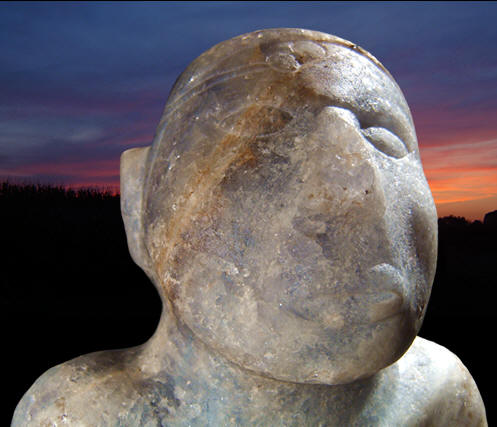
THE TOLU FLUORITE STATUE
A.D. 1150 TO 1200
CRITTENDEN COUNTY, KENTUCKY
This picture shows the head of the
Tolu figure from the right side. The beaded forelock can be seen on
the center forehead. The Tolu fluorite statue is the only known
statue that was sculpted with a beaded forelock. The almond shaped
eyes are clearly seen in this picture and the high cheek bone on the
left side is very clear. Another very impressive feature is the band
of color that lays across the eye and right cheek. It's possible
that this artistic feature was deliberately incorporated into the
statue's design to enhance some type of mythological story line. |
|
|
The seating position of the Tolu statue is reported by
Smith and Miller to be the most common for male figures although all
three of the other fluorite statues (plus the fourth fire damaged
example from western Tennessee) are seated with the right knee up at
chest level. The Tolu figure is the only fluorite statue that is seated in the lotus position with legs
crossed and each hand resting on a knee. Smith and miller report that
the most common female seated position is kneeling with both legs tucked
underneath. |
|
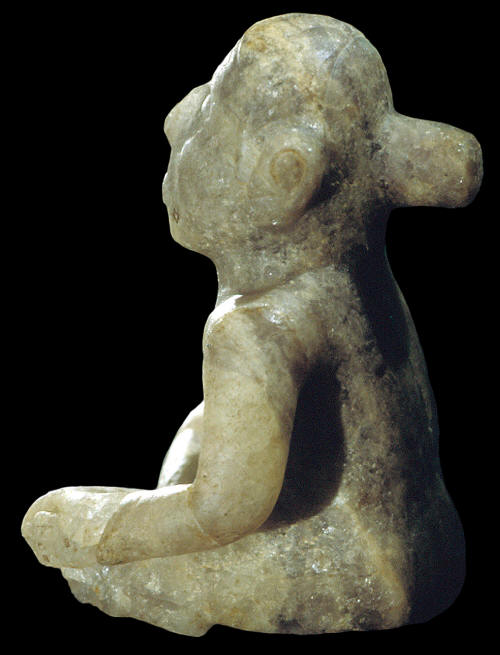
THE TOLU FLUORITE STATUE
A.D. 1150 TO 1200
CRITTENDEN COUNTY, KENTUCKY
This
picture clearly shows the overall posture of the Tolu fluorite
statue. The figure is seating in the lotus position with a straight
back that is slightly leaning forward. The hair knot is a
type typically used to represent a male. |
|
|
One of the most interesting carvings on the Tolu statue are
the two beads located at the top of the forehead in the center. They are
carved to represent beads attached to two parallel lines that represent
a forelock of hair. The design is described as a Braden-A style of beaded forelock which is
a Cahokia trait. The Tolu fluorite statue is the only known statue that
was sculpted with a beaded forelock. |
|
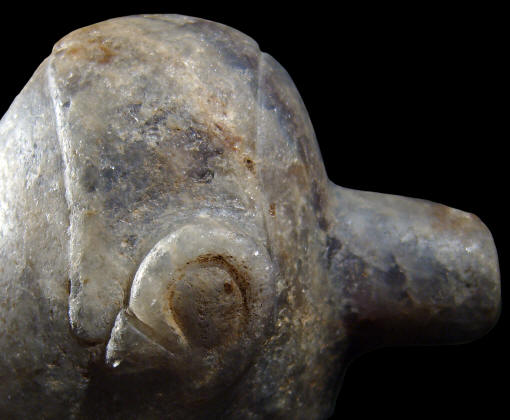
CLICK ON PICTURE FOR LARGER IMAGE
THE TOLU FLUORITE STATUE
A.D. 1150 TO 1200
CRITTENDEN COUNTY, KENTUCKY
This picture shows a close up view of
the finely carve ear on the left side and some of the hair line
engraving. |
|
|
The hair style
of the Tolu statue is also very well represented. Besides the beaded
forelock there is a line that follows the upper forehead hairline down
to what could be described as sideburns. At the back of the head, there
is another line that follows down each side to the back of the ears.
This line also has another faint line that parallels it. At the back of
the head there is also a very impressive carving of a hair knot that is
the type typically used to represent a male. It's important to note that some of the carved
lines on the heads of statues may also suggest or represent some type of
helmet or other type of headgear. |
|
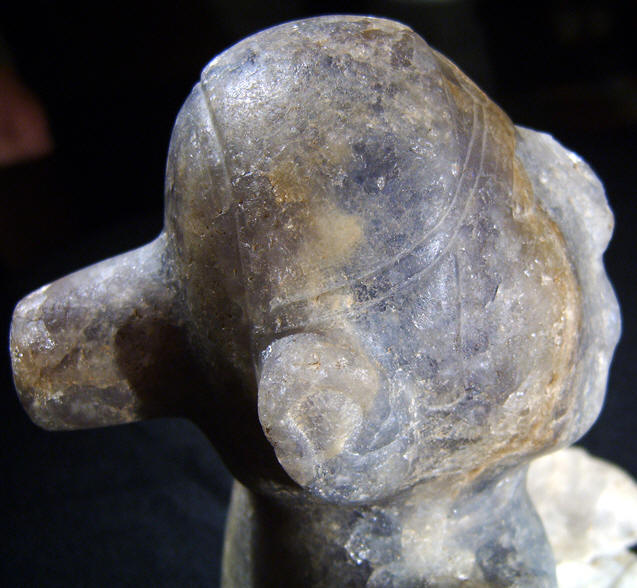
CLICK ON PICTURE FOR LARGER IMAGE
THE TOLU FLUORITE STATUE
A.D. 1150 TO 1200
CRITTENDEN COUNTY, KENTUCKY
This close up view of the left side
of the Tolu statue shows some of the engraved hair features. Besides the beaded forelock there is a line that follows
the upper forehead hairline down to what could be described as
sideburns. At the back of the head, there is another line that follows
down each side to the back of the ears. This line also has another faint
line that parallels it. At the back of the head there is also a very
impressive carving of a hair knot that is the type typically used to
represent a male. It's also important to note that some of the carved
lines on the heads of statues may also suggest or represent some type of
helmet or other type of headgear. |
|
|
The Tolu statue has ears that are finely carved in relief,
eyes that are almond shaped and a mouth that is closed with no teeth or
tongue showing. The body was also sculpted in natural proportions. The
upper chest is nicely carved and the abdomen is slightly depressed. Both
of the hands also have their fingers and thumbs nicely carved and
situated on the knees. |
|
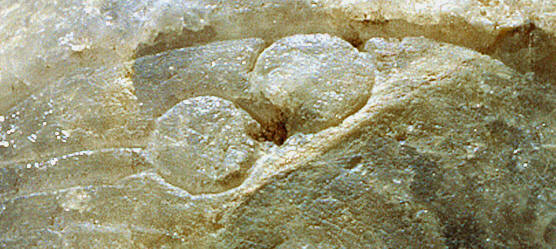
THE TOLU FLUORITE STATUE
FORELOCK BEADS
A.D. 1150 TO 1200
CRITTENDEN COUNTY, KENTUCKY
The Tolu fluorite
statue is the only known statue that was sculpted with a beaded
forelock. This picture shows a very close view of the two engraved
beads and the two parallel lines that connect with them. One of the
most interesting carvings on the Tolu statue are the two beads which
are located in the center on the top of the forehead. They are
carved to represent beads attached to two parallel lines that
represent a forelock of hair. The design is described as a Braden-A
style of beaded forelock which is a Cahokia trait. |
|
|
The bottom of
the statue is very intricately carved. Both legs are carved in deep
relief. An erect penis and testicles were also intricately carved in
relief by removing a considerable amount of material around the carving. The sphincter muscle that opens and closes
the anus is especially well represented with two concentric rings. |
|
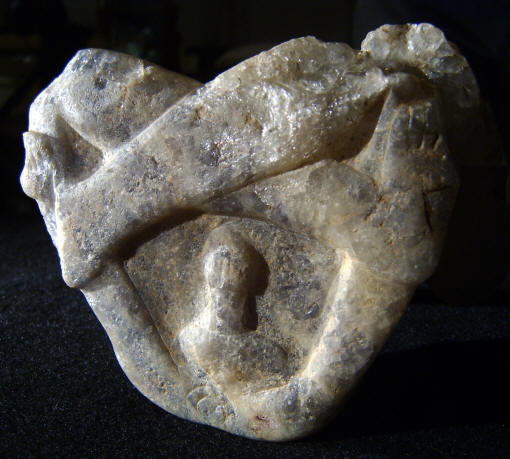
CLICK ON PICTURE FOR LARGER IMAGE
THE TOLU FLUORITE STATUE
GENITAL CARVING UNDERNEATH
A.D. 1150 TO 1200
CRITTENDEN COUNTY, KENTUCKY
This picture shows the
intricately carved underside of the Tolu statue. Both legs are carved in
deep relief. An erect penis and testicles were also intricately carved
in relief by removing a considerable amount of material around the carving. The sphincter muscle that opens and closes
the anus is also especially well represented with two concentric rings
and one or more perpendicular lines within the rings. |
|
|
Another interesting
feature of the Tolu statue, which may have been deliberately
incorporated into the statue's design, is the colorful band of
yellow-orange that lays across the forehead down through the right eye.
This statue is so uniquely detailed that it's possible this band of
color might represent some part of a story line within Mississippian
cultural mythology. |
|

ARTIFACTS MADE OF FLUORITE
MISSISSIPPIAN CULTURE
ILLINOIS
These six artifacts were all made from
colorful fluorite crystals. They were found on different sites in
southern Illinois. They represent a few of
the small but very colorful beads,
pendants and ear ornaments that have been reported from the area
around what is known as the Illinois-Kentucky fluorspar region. |
|
|
There is no
question that the Tolu statue was carved by a highly skilled craftsman
who could reproduce, in stone, an important mythological figure. It's
logical to assume that it probably represents one of the powerful beings
within the Mississippian cosmology of the time. The Tolu figure is an
important artifact that will be studied for a long time. Research will
eventually unlock more of it's secrets. |
|
"REFERENCES"
1929, Moorehead, Warren K., "The
Cahokia Mounds," p. 99.
1954, Creason, Joe "Solid Old Citizen," The Sunday Magazine Of
The Courier-Journal, October 3, 1954.
2007, Reilly III, Kent and Garber, James F., "Ancient Objects And
Sacred Realms," p. 228.
2009, Smith, Kevin E., & Miller, James V., "Speaking With The Ancestors, Mississippian
Stone Statuary Of The Tennessee-Cumberland Region," pp. 144-153.
2010, Marlen, James, "The Tolu Temple Statue," Prehistoric
American, pp. 4-5.
Personal Communication with Jim Marlen
|
|
RECENT
LISTINGS HOME
ORDERING |